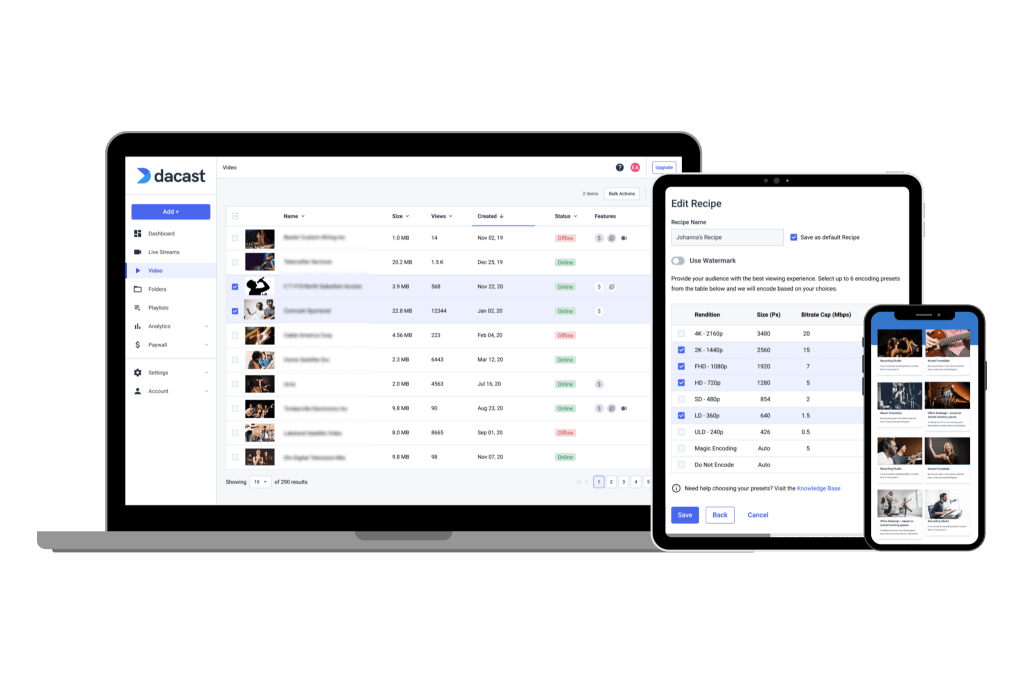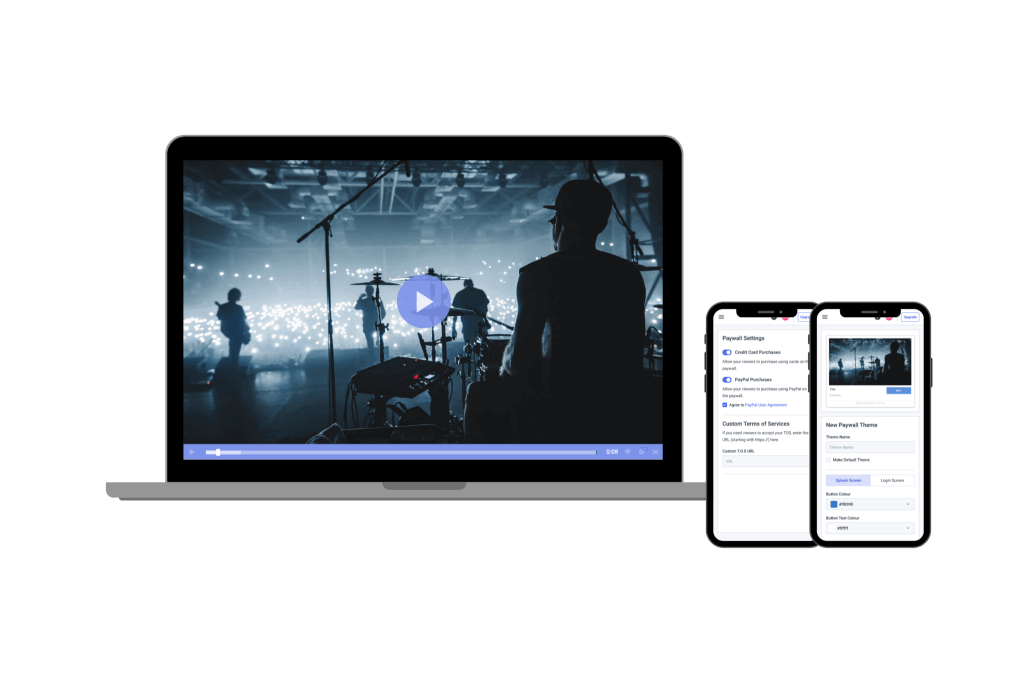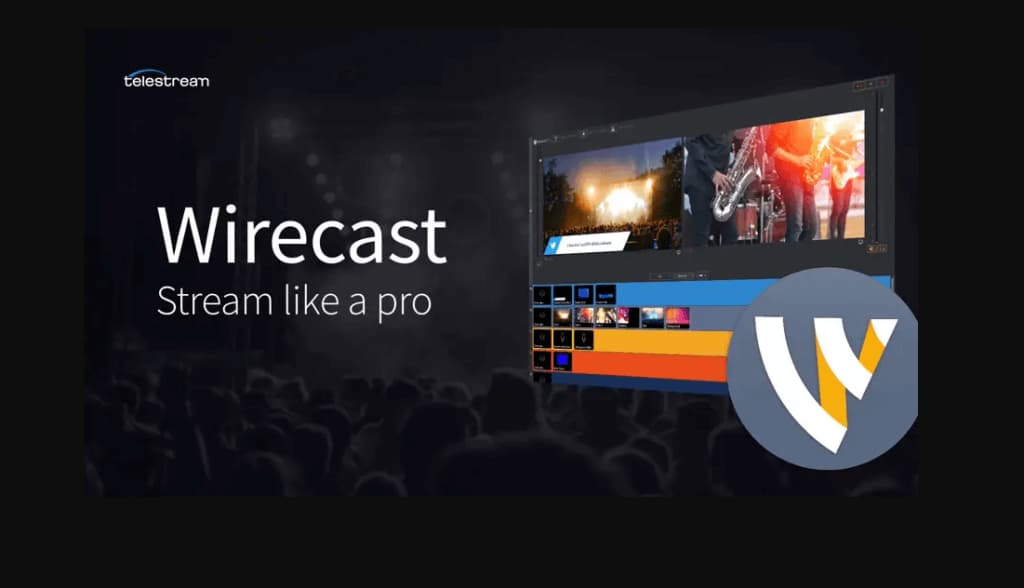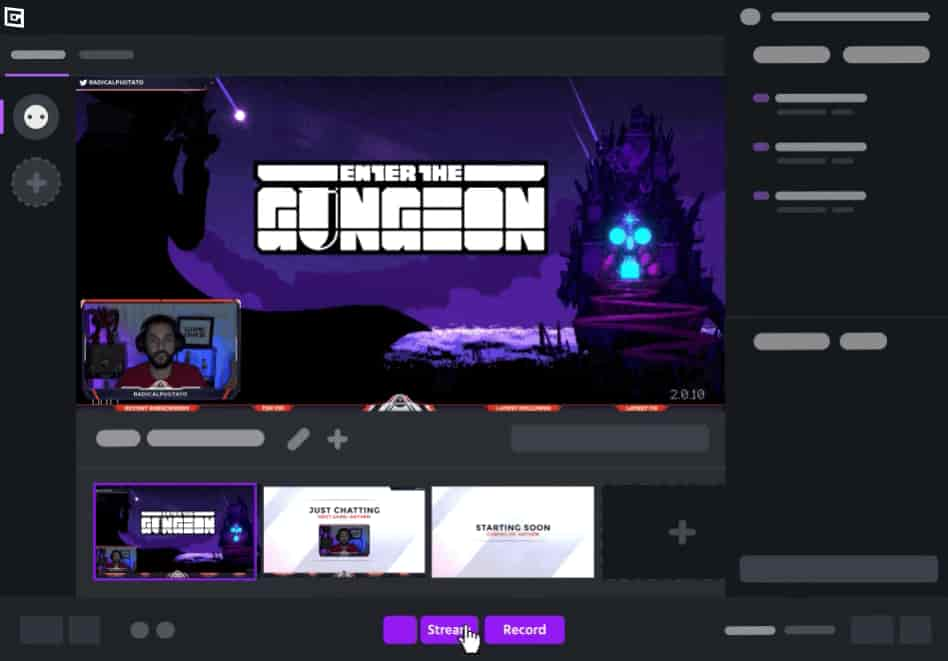RTMP vs. RTSP: Which Streaming Protocol is Right for You?
If you stream online video content, it needs to be seamless. Today, viewers demand the highest quality content. If they have difficulty watching your video stream, you could lose viewers. Therefore, ensuring you stream video, audio data and media files in the best quality is paramount to your online content success.
Live video streaming is particularly popular and requires the proper set-up. Without using the right protocol, your social media platforms’ streams and ability to stream video and audio data will be compromised.
In this article, we’ll cover two of the most popular streaming protocols, RTMP and RTSP. These streaming protocols are responsible for your viewers being able to view your content. Depending on your equipment and needs, one will be better for you than the other. We’ll compare them and detail the differences and pros and cons so you can choose the best one for your video and audio streams. By the end, you’ll be able to make the most informed decision on the streaming protocol that’s right for you.
Table of Contents:
- RTMP vs RTDP: Streaming Protocols Explained
- RTMP vs RTSP: Which is Right for Your Needs?
- Cloud Transcoding and RTMP
- How to Convert RTMP to RTSP
- RTMP vs RTSP vs WebRTC
- RTSP vs RTMP vs ONVIF
- FAQs
- Conclusion
RTMP vs RTSP: Streaming Protocols Explained
Before we compare RTMP vs. RTSP, let’s define streaming protocols. A video streaming protocol is a media delivery method that involves breaking videos into smaller bits and sending them to the receiver’s server before reassembling them. Some common types of streaming protocols include:
- HTTP Live Streaming (HLS)
- Real-Time Messaging Protocol (RTMP)
- WebRTC
- Secure Reliable Transport (SRT)
- Real-Time Streaming Protocol (RTSP)
- Dynamic Adaptive Streaming over HTTP (MPEG-DASH)
RTMP and RTSP video streaming protocols allow users to view content in any web browser and on most mobile devices.
RTMP and RTSP are both streaming protocols. Streaming data through these protocols entails having sets of rules that govern how data travels from one system of communication to another. If the video data you’re trying to send to your viewers is a car, then the streaming protocol is the road that the car takes to get from one place to another.
The two most common streaming protocols are RTMP and RTSP, which is why you will often see comparisons between RTSP and RTMP.
While they both accomplish similar goals, when we compare RTSP vs RTMP there are some important differences.
What is RTMP?


RTMP allows users to view content in any web browser and on most mobile devices.
RTMP stands for Real-Time Messaging Protocol. It is a standardized method of moving multimedia files over the internet.
Developed by Macromedia (now owned by Adobe), RTMP streams low-latency, on-demand content efficiently. This data can be pre-recorded or live-streamed, but RTMP technology is most commonly used today for live-streamed content.
While most live video streaming software supports RTMP ingest, most online video streams utilize the HLS http live streaming” protocol. HLS – HTTP Live Streaming – protocol was pioneered by Apple and is compatible with nearly all mobile devices, game consoles, smart televisions, and computers on the market. The real-time messaging protocol transmits the audio and video files from the RTMP encoder to the video hosting platform, and HLS transmits the files from the hosting platform to individual viewer devices.
RTMP is a prevalent streaming protocol, offered as a featured option by most of the leading live streaming platforms such as Dacast, Brightcove, and Wowza.
Pros and Cons of RTMP
Using RTMP in your live video streaming comes with a variety of positive and negative points:
Pros of using RTMP:
- Low latency: Low latency allows your live video stream to maintain a stable connection and video feed for the viewer, even if the internet connection is unreliable. This provides your viewers with fewer “lags” when watching your videos with a shaky internet connection, allowing them to quickly resume the stream once their internet connection stabilizes. RTMP allows for a better viewing experience.
- Adaptable: An adaptable feed means your viewers aren’t locked into watching your feeds in one linear direction. Adaptability allows them to skip and rewind parts of the feed or to join a live stream after it’s begun. Most viewers now expect the videos they watch to have this capability.
- Flexible: RTMP allows you to integrate a variety of media types into one cohesive package, seamlessly blending audio, video, and text. Additionally, you can have multiple variations of media channels, such as streaming both MP3 and AAC audio streams or streaming MP4, FLV, and F4V videos. It allows for RTMP audio streaming.
Cons of Using RTMP:
- Not supported by HTML5: RTMP is supported by Flash players, a format that’s well on its way toward obsolescence. HTML5 players are quickly becoming the modern standard, but RTMP cannot play on HTML5 players without a converter such as HLS. Using RTMP requires other tools.
- Bandwidth issues: RTMP streams can be especially vulnerable to issues of low video bandwidth. This can cause frequent, frustrating interruptions to your streams that ruin the experience for your viewers.
- HTTP incompatible: You cannot directly stream an RTMP feed over an HTTP connection. In order to use an RTMP stream on your website, you have to connect to a special server, such as the Flash Media Server, and use a third-party content delivery network (CDN).
What is RTSP?


RTSP is common for CCTV and IP camera streams.
Wondering what RTSP is used for? RTSP, also known as Real-Time Streaming Protocol, is a lesser-known protocol for streaming video online.
This protocol was designed to control the streaming media servers, used in entertainment and communications systems. RTSP servers sit between the live stream and the viewer, ensuring smooth communication among media players and servers and allowing viewers to issue “play,” “pause” and “record” commands while live streaming.
RTSP is a streaming protocol designed to control live streams by facilitating audio and video transmissions between two endpoints without the need to transmit data.
When the RTSP controls the server-to-client connection, video-on-demand streams are used; when it controls the client-to-server connection, RTSP utilizes voice recording streams.
RTSP commonly is used for Internet Protocol (IP) camera streaming, such as those coming from CCTV or IP cameras.
Pros and Cons of RTSP
Before you choose an RTSP live stream for your video delivery, it’s important to understand the benefits and downsides of its use:
Pros of using RTSP:
- Segmented streaming: Rather than forcing your viewers to download an entire video before watching it, the RTSP stream allows them to watch your content before the download is complete.
- Customization: By utilizing other protocols, such as Transmission Control Protocol (TCP) and User Datagram Protocol (UDP), you can create your own video streaming applications.
Cons of using RTSP:
- Less popular: Compared to other media streaming protocols, the RTSP protocol is far less popular. Most video players and streaming services do not support RTSP streaming, making it more difficult to broadcast your stream in your browser. To broadcast an RTSP stream, you must use a separate RTSP live streaming service.
- HTTP incompatible: Like RTMP, you cannot directly stream RTSP over HTTP. Because of this, there is no easy, straightforward way to stream RTSP in a web browser, as RTSP technology is designed more for streaming video on private networks such as security systems within a business. However, you can stream RTSP using additional software embedded in your website.
- Limited scalability: The little compatibility range of RTSP makes it an unsuitable choice for large scale events with high volume streaming requirements.
RTMP vs. RTSP: Which is Right for Your Needs?
Choosing between RTMP and RTSP streaming protocols greatly depends on your individual business needs and how many extra steps you are willing to take to make your content playable on your website.
To make this decision, it’s important to understand how each type of streaming works.
How RTMP Works for Streaming


Selecting between RTMP and RTSP streaming depends on your business needs and the platform you choose.
RTMP streaming is based on the Transmission Control Protocol (TCP) and is designed for through Flash player.
Because of its versatility, RTMP is secure and can stream audio, video, and text files in any web browser and mobile device that is compatible with Flash. This means RTMP streaming is widely accessible to viewers without the need for secondary applications or RTMP streaming platforms to make a player compatible. It also makes your task of filming, uploading, and sharing your live-streamed videos easier. RTMP is made for modern streaming media needs.
To capably live stream with RTMP streaming protocol, you will need a live-streaming camera, a capture card or hardware video encoder, and live video streaming software. Once you have all the right equipment, the RTMP streaming protocol will help get your content to your viewers.
How RTSP Works for Streaming
Where RTMP uses only TCP to transmit data, RTSP utilizes two network communication protocols: TCP and UDP.
TCP issues and receives the stream’s control commands and UDP delivers the audio, video, and data to the streaming server. Because of the use of these two network communication protocols, an RTSP live stream allows users to begin watching a video while the stream is still being downloaded.
Because RTSP is not designed to stream directly in your web browser, embedding an RTSP stream on your website is more complicated than RTMP. To stream RTSP video content, you will need additional software to make your stream compatible.
How RTMP Streaming Integrates with Dacast
At Dacast, we work hard to ensure that you have the most easy-to-use, seamless white-label streaming solution for online video delivery.
To give your viewers the smoothest playback experience, Dacast offers adaptive bitrate streaming. This adaptive bitrate streaming means that your users will view the highest-quality file that will reliably play on their individual devices and internet connection.
In order to easily offer adaptive bitrate streaming, Dacast utilizes cloud transcoding to help you create various levels of file quality without much effort on your end. RTMP protocol is the backbone of this service.
Cloud Transcoding and RTMP
When using the term “video transcoding,” refers to the process of taking a video file from one format and re-encoding it into a different format. For example, transcoding can take an MP4 file and re-encode it into FLV, allowing the video to be more widely playable.
By transcoding in the cloud, you save processing power, time, and money over transcoding all the files locally on your computer. Additionally, cloud transcoding automatically re-encodes your files into all available formats without you needing to do anything or have any specific technical knowledge. RTMP cloud transcoding makes it easier to get quality videos to your viewers.
Because RTMP allows your viewers to watch your videos in different formats on nearly any video player, cloud transcoding makes your videos ready for this varied consumption.
How to Convert RTMP to RTSP
Converting RTMP to RTSP is essential for efficient streaming across platforms. RTMP (Real-Time Messaging Protocol) is widely used for live broadcasts because of its low latency and strong connection. However, many modern devices and applications prefer to use RTSP (Real-Time Streaming Protocol), which is known for its flexible streaming capabilities.
To convert RTMP to RTSP, you’ll probably need an RTMP server that supports both protocols. You can use RTMP to RTSP converter tools like Frigate RTMP, which is an open-source software designed for video surveillance, can help in the conversion process. This is especially true for multiple streams. The key difference between RTMP and RTSP lies in how they’re used. RTMP is optimized for delivering content from an encoder to a server while RTSP is great for serving content in real-time.
Understanding the technical differences between RTMP and RTSP will help ensure smoother video streaming across devices and networks.
RTMP vs RTSP vs WebRTC
comparing RTMP vs RTSP vs WebRTC, RTMP vs WebRTC, or RTSP vs WebRTC, it’s important to consider their strengths and best uses. To start, RTMP is a reliable option for live streaming, often used to send video from an encoder to a streaming server such as a live broadcast. However, RTMP is not natively supported by many modern browsers.
On the other hand, RTSP is designed for video streaming to end-users, making it a great choice for surveillance systems or applications that require real-time media delivery. It’s flexible and efficient at delivering streams directly to compatible devices.
WebRTC (Web Real-Time Communication) is a more modern solution. It’s focused on peer-to-peer communication with ultra-low latency. Unlike RTMP or RTSP, WebRTC doesn’t rely on an intermediary server. This makes it ideal for live, real-time interactions such as video calls or online meetings.
To summarize, when choosing between RTMP vs RTSP vs WebRTC, RTMP is great for streaming to servers whereas RTSP works well for video playback and WebRTC for real-time peer-to-peer communication.
RTSP vs RTMP vs ONVIF
When comparing RTSP vs RTMP vs ONVIF, each protocol has its own particular strengths and applications. When we look at RTSP vs ONVIF, we see that RTSP is commonly used for direct video streaming to end-users, such as in surveillance systems or media applications. Usually, it uses port 554 and offers low-latency streaming. This means it is ideal for real-time viewing.
On the other hand, ONVIF (Open Network Video Forum) is a standard primarily used in the security and surveillance industry. It enables different devices like cameras and recorders to communicate with each other. While RTSP vs ONVIF focuses on streaming versus device compatibility, ONVIF also supports HTTP-based communication, making integration easier.
Then, RTMP. RTMP is more suited for broadcasting video from an encoder to a streaming server. It uses port 1935 and provides a stable connection. However, it’s not widely supported by modern browsers. RTSMP is often used in live broadcasting applications and services that require low latency for large-scale streaming.
To summarize, RTSP excels in real-time streaming, RTMP in broadcast scenarios, and ONVIF in device interoperability.
How Does Cloud Transcoding Fit in with RTMP?
RTMP is the most versatile streaming protocol in use, and using it allows your users to view videos in a range of formats. By using cloud transcoding to ensure your files are properly encoded in each format, your users can view your content on any web browser and nearly every mobile device, regardless of the file format their device plays.
Every video producer has their favorite video encoding platform. Dacast seamlessly integrates with three popular encoding platforms: OBS Studio, Wirecast, and XSplit.
1. OBS Studio


OBS Studio is free and open-source software for video recording and live broadcasting.
Open Broadcaster Software (OBS) Studio is a free, open-source video encoder compatible with Windows, macOS, and Linux systems.
While it is more basic at its core than many other software platforms available, it offers a wide range of plugins to enhance its capabilities and functionality. Many of these plugins help elevate OBS to the level of many of the pricier video encoders.
OBS enables users to create professional videos, with features like its intuitive audio mixer and modular UI. It offers a wide range of customizable transitions, with hotkeys settings that allow you to seamlessly toggle between scenes, mute audio sources, etc.
Key Features of OBS Studio:
- Support for audio, video, image, web browser, and graphics sources
- Supports video recording and RTMP live streaming
- Switch between multiple sources, including a camera using a capture card
- Variety of community-developed plugins
- Studio mode and multi-view features
- Pre-program scenes with multiple elements
Pricing:
OBS Studio is open-source and completely free. There is no cost to accessing and using this software. Version 30.2.3 was released on August 15, 2024, and is available for download here for macOS 11.0 or newer, Windows Windows and Ubuntu operating systems.
For the Linux version, FFmpeg is required.
OBS Studios is great for beginner broadcasters, as it is free and easy to learn with a little effort. It offers RTMP live-streaming support.
2. Wirecast


With unlimited inputs, unlimited destinations, and simultaneous video conferencing, Wirecast Studio is the perfect live-stream broadcasting software.
Developed by Telestream, Wirecast is a more robust platform with a wide variety of professional tools to make live streaming easier. From small producers to major brands, Wirecast has a solution that will fit your needs.
Wirecast is designed to support recording and streaming to various destinations using RTMP or SRT. It supports transmission to platforms such as YouTube, Facebook Live, Twitter, and Vimeo Live.
Another Wirecast feature that makes it stand out is its widely supported control surface integrations and PTZ control. It also gives users access to a huge stock media library, with over 500,000 media assets.
Key Features of Wirecast:
- Input sources from cameras, mics, webcams, IP cameras, capture cards, and desktops
- Offers instant replay, scoreboards, clocks, and timers, making it ideal for sports applications
- Audio mixer and up to 8 audio tracks
- Built-in video conference tool
- Simultaneously stream to more than one location
- Stream and record simultaneously, with re-stream and live caption options
Pricing:
The latest version of Wirecast is 14.3.3. It is the newest full version and was released on October 4th, 2021. It features several enhancements and fixes, regarding bugs and other technical mishaps with the previous version, and includes FBLive polling, re-written WebStream plugin, and Virtual Camera improvements.
The software comes in two versions:
- Wirecast Studio for enhanced live production & streaming: pricing is $35/month billed monthly and $24.92/month billed annually
- Wirecast Pro for advanced live production and streaming: pricing is $46/month billed monthly and $33.25/month, billed annually
Both versions offer free trials. However, the Pro version includes several features not available in the Studio version. Some of these features include ISO recording, PTZ camera control, multi-track audio recording, and multi-track audio routing.
3. XSplit


XSplit’s streaming software is intuitively designed, and easy to use suite of video content creator tools.
XSplit comes in two versions: Gamecaster and Broadcaster. The Gamecaster version is focused on live streaming of video gameplay. The XSplit Broadcaster version, on the other hand, offers simple, powerful live streaming and recording software. The platform seamlessly integrates with a wide variety of popular other streaming platforms and gear, including products from Discord, Logitech, and Razer.
Key Features of XSplit:
- Offers support for a range of inputs, including all major capture cards, videos, music, and webcams
- Professional production features, including enhanced audio
- Locally record streams
- Integrated chat function
- Variety of other custom plugins and integrations
- Edit and securely upload video recordings
Pricing:
The pricing plans for XSplit Broadcaster Premium for 12 months are as follows:
- VCam Premium: $100
- Broadcaster Premium: $140
Regardless of your individual needs and budget, there’s a high-quality video encoding platform compatible with Dacast that will work for you when choosing the RTMP streaming protocol.
FAQs
1. Is RTMP faster than RTSP?
RTMP has a lower latency with wider compatibility features compared to RTSP. This makes it an ideal choice for situations where speed and fewer delays are required. It is also built to handle live streaming over the internet, while RTSP is a video delivery ecosystem that is more suitable for streaming videos over local networks.
2. How to Convert RTSP to RTMP?
You can convert RTSP to RTMP using transcoding software such as FFmpeg. It enables you to decode, encode, transcode, mux, and demux video files from one format to another.
3. What are the Disadvantages of RTSP?
Some drawbacks of using RTSP streaming protocol include:
- Low compatibility
- Less popularity than RTMP
- Limited scalability
- No built-in encryption, which can jeopardize security
- Limited data protection support
5. How does RTMP Streaming Work?
RTMP streaming works by using an encoder to break down big audio and video files into smaller components before sending them to streaming servers.
Conclusion
Both the RTMP and RTSP streaming protocols offer unique benefits for broadcasters. RTMP is widely compatible and flexible and allows viewers to select their choice of web browser or mobile device to view content. RTSP, on the other hand, works better for localized live streams or in utilizing additional software to improve its web browser and live streaming compatibility.
Ultimately, which one is best for your media streaming purposes depends on the type of content. Now that you know what both protocols are, the differences and the pros and cons, you can choose the right one for your needs.
However, if you’re looking for a robust and easy-to-use platform with great streaming capabilities, try Dacast. With Dacast, you get a streamlined platform for a fully compatible media stream. Whatever you want to stream, Dacast will seamlessly elevate your content.
Dacast was selected as the 2019 Streaming Media Readers’ Choice for Best Small/Medium Business Platform.
You can try Dacast and all its features free for 14 days starting today.
For exclusive offers and regular live-streaming tips, join our LinkedIn group. Do you have questions or feedback on this article or streaming protocols in general? We’d love to hear from you in the comments below.
Thanks for reading, and happy streaming.

 Connect
Connect
 Events
Events Business
Business Organizations
Organizations Entertainment and Media
Entertainment and Media API
API Tools
Tools Learning Center
Learning Center Support
Support Support Articles
Support Articles